Just looking for our Best Author Website examples list?
Why a Professional Author Website is Your Key to Success
A professional author’s website is a crucial component of an author’s success. Whether you’re a seasoned bestselling author or just starting, having a polished, user-friendly site can make all the difference in how you connect with your audience and build your brand. In a world where readers and potential clients often decide their engagement based on your digital presence, a well-designed website can boost your visibility and establish trust.
A WordPress site or even a customized Squarespace template allows you to present a compelling bio, showcase your books, and create an unforgettable experience for your visitors. But it’s not just about the visuals. A high-performing website also serves as an essential hub for book marketing, helping you sell books directly, grow your email list, and ultimately, drive sales. With features like a mailing list signup or the option to buy your book with ease, your website becomes a pivotal part of your author business strategy.
But great design isn’t just about aesthetics. It’s about crafting a seamless user experience that encourages visitors to stay longer, sign up for updates, and become loyal readers. From choosing the right domain name to integrating social media and optimizing for SEO, every element of your site plays a role in its success. A professional website helps position you as an expert in your field and provides a platform where readers can engage, connect, and come back for more.
As you dive into this guide, you’ll learn why investing in a high-quality, functional website is one of the smartest business moves you can make as an author. Whether you’re using a website builder or working with a developer, this blog will walk you through the best practices for creating an impactful online presence that drives results and supports your growth as a writer.
Website Planning & Purpose
The planning phase of website design is the foundation for building a successful and functional site. For authors, this phase is especially crucial because your website needs to represent your work, your brand, and voice. Whether you’re designing a site to promote your books, engage with readers, or establish your authority in the literary world, the planning phase helps clarify your goals and sets the direction for the entire project.
During this phase, the first step is defining the purpose of the website. Are you aiming to sell books directly, grow your email list, share blog content, or provide a portfolio of your writing? Understanding your core objective will guide all other decisions, from choosing the best platform to selecting the right design elements. A professional website should be an extension of your identity, serving both functional and marketing purposes. By aligning the design with your goals, you’ll create a site that speaks directly to your audience and converts them into readers.
Next, consider the user experience (UX) and how visitors will interact with your site. It’s important to plan a clear, intuitive layout that makes it easy for readers to navigate and find what they’re looking for. This includes strategically placing CTAs (calls to action), such as signing up for your email list or purchasing your latest book. Planning the structure of your website should focus on creating a seamless experience for your visitors, allowing them to quickly engage with your content and ultimately take action.
Another key aspect of planning is the content strategy. What will your site include beyond your author bio? Consider elements like a blog, book descriptions, a media kit, and a dedicated page for readers to purchase your book. High-quality content that aligns with your brand and engages your audience is crucial for both SEO and user engagement. As you plan your content, ensure that each page is purposeful and contributes to the overall website experience. Having a strong content plan ensures that your site has depth, making it easier to draw in new readers.
Additionally, technical considerations like choosing the right website builder, deciding whether to use a template or a custom design, and selecting a domain name are all integral to the planning phase. The platform you choose should align with your needs and allow for future growth. For example, platforms like WordPress provide flexibility and scalability, making it easier to manage your site as you build your readership and expand your content. To learn more about key design principles during this phase, check out our guide on the core principles of web design.
By carefully planning your website’s structure, content, and user experience, you lay the groundwork for a site that meets your goals and provides long-term value. This is the essential first step in turning your website into an impactful tool that helps you engage your audience and grow your business.
Design Principles
When designing a website for authors, several key design principles must be followed to ensure that the site is visually appealing, functional, user-friendly, and aligned with the author’s brand. A well-designed author website should engage visitors, provide a smooth navigation experience, and convert traffic into loyal readers or customers. Here are the core design principles to consider when building an author website:
1. Simplicity and Clarity
One of the most important design principles is simplicity. Avoid overcomplicating the design with too many elements or overly complex navigation. The goal is to create a clean, organized, and easy-to-navigate site that allows visitors to find what they need quickly. An effective author website should focus on the essentials, such as book descriptions, a bio, contact information, and options to buy your book. A simple layout ensures that users can easily absorb content without feeling overwhelmed, which is key to keeping visitors engaged.
2. Consistency in Branding
Your website should reflect your personal brand as an author. Consistent use of colors, fonts, and images that align with the themes and tone of your writing helps establish a cohesive visual identity. If you’re a thriller writer, a darker color palette with sharp fonts may work best, while a romance author might opt for softer tones and elegant typography. Your author bio and other content should also carry through this tone, helping visitors immediately understand what to expect from your work. Consistency creates a professional and trustworthy image for your audience, which is essential for credibility.
3. Responsive Design
Given that a significant number of website visitors access sites on their mobile devices, responsive design is essential. A responsive website automatically adjusts its layout based on the screen size, ensuring that the site looks great on smartphones, tablets, and desktops alike. Mobile optimization is crucial for keeping bounce rates low and ensuring visitors have a seamless experience no matter the device they use. A responsive site ensures that your readers can access your content on the go, improving the chances of them returning and engaging with your list of signups.
4. User-Friendly Navigation
Clear, intuitive navigation is fundamental for a website’s success. Visitors should be able to find information easily and quickly, without getting lost in menus or being overwhelmed by too many options. For an author website, this means having a clearly visible menu with options such as “Home,” “Books,” “Blog,” “About the Author,” and “Contact.” Additionally, having prominent CTAs (calls to action), such as buttons to purchase your book or subscribe to a newsletter, encourages interaction and keeps visitors engaged. Thoughtful navigation ensures that readers can explore your content without frustration.
5. Visual Hierarchy
Good design uses visual hierarchy to guide visitors’ attention. By using different font sizes, colors, and spacing, you can create a hierarchy that directs the user’s focus to the most important elements on each page. For instance, your book titles or bio should stand out using larger fonts or bolded text, while less critical information, such as copyright notices, should be in smaller text. Visual hierarchy makes a website easier to scan and navigate, enhancing the overall user experience and making key actions, like signing up for newsletters or purchasing books, more prominent.
6. Engaging Visuals and Imagery
The use of high-quality images is a key component of website design. For authors, this can include professional photos of yourself, book cover images, and any relevant visuals that connect with your genre. These images should be strategically placed to break up text and keep the site visually appealing. However, be mindful not to overwhelm the page with too many images, as it can distract from the content and slow down page load times. High-quality imagery enhances the storytelling aspect of your website, helping visitors connect with you and your work.
7. Clear Calls to Action (CTAs)
Every effective author website should have clear and compelling CTAs that guide visitors toward the next steps. Whether it’s purchasing a book, subscribing to a monthly newsletter list, or contacting you for speaking engagements, CTAs help drive conversions. Make sure your CTAs stand out visually and are placed strategically throughout the website, such as in the header, at the end of blog posts, or on dedicated landing pages. Clear CTAs create a pathway for readers to engage with your content, fostering stronger relationships and improving your chances of converting them into loyal fans.
8. Optimized Page Speed
Website speed plays a crucial role in both user experience and SEO. Slow loading times can frustrate visitors and lead them to abandon the site. A fast, well-optimized website ensures that your audience has a positive experience, which can ultimately affect your site’s ability to rank well in search engines. Compress images, minify code, and use a reliable hosting service to ensure your author website loads quickly and runs smoothly.
9. SEO Optimization
While the design of your website is important, it must also be optimized for search engines. By incorporating relevant keywords, such as book marketing, and ensuring that all on-page SEO elements (like titles, meta descriptions, and header tags) are properly utilized, you increase the likelihood that your website will rank for important search terms. SEO optimization ensures that readers searching for your books or similar authors can easily find your site, boosting your visibility and driving traffic to your pages.
10. Social Media Integration
Social media is a powerful tool for authors to engage with their audience. Integrating social media links or live feeds into your website makes it easy for visitors to follow you and stay updated on your latest releases, blog posts, or events. By incorporating social media buttons or sharing options on your site, you extend your reach and encourage visitors to share your content with their own networks, further boosting your visibility and engagement.
By following these core design principles, you ensure that your website looks professional and functions as an effective tool to engage readers, showcase your work, and grow your audience. These principles help lay the foundation for a site that supports your long-term goals as an author and positions you for success in the competitive world of book marketing.
Content & Navigation
When designing a website, structuring content and navigation is crucial to ensure visitors can easily access the information they need while maintaining a seamless and enjoyable experience. Proper content and navigation design can significantly impact engagement, retention, and conversion rates, ultimately contributing to the success of the author’s online presence. Here’s how to effectively structure content and navigation for an author’s website:
1. Clear and Simple Navigation
Effective navigation is the backbone of a well-structured website. The main menu should be clean and intuitive, guiding visitors to the most important sections of the site without causing confusion. For an author’s website, focus on including the following key elements in the navigation:
- Home – This serves as the landing page, providing an overview of the author’s work, brand, and key updates.
- About the Author – This section should include a brief yet compelling bio detailing the author’s background, accomplishments, and writing journey. It’s an opportunity to connect with readers on a personal level.
- Books – Showcase the author’s books, with a dedicated page or section for each title. This could include a brief synopsis, book covers, and links to purchase, as well as reader reviews.
- Blog – If the author regularly writes content, a blog section is important for sharing updates, insights, and articles related to their writing or personal interests. It also plays a role in SEO by helping the site rank for relevant keywords.
- Contact – This page should allow readers, media, and potential collaborators to get in touch with the author. Include a contact form, social media links, and possibly an email address for professional inquiries.
- Media & Press – This section is especially important for authors who are looking to expand their visibility. It should include media kits, press releases, interviews, and other content that can be shared with journalists or event organizers.
When designing navigation, keep the menu options minimal, using simple and descriptive labels for each page. Avoid overcrowding the menu with too many links, which could overwhelm visitors. If you have additional content, consider using dropdown menus or sidebars to organize supplementary sections without cluttering the main navigation.
2. Structured Content Layout
Once the navigation is established, the next step is to organize the content in a way that enhances readability and engagement. Here’s how to structure content on an author’s website:
- Landing Page: The home page is the first impression visitors will have of the author. It should offer a clear and concise overview of who the author is and what they offer. This might include a featured book, a short author bio, and links to important sections like the Books and Blog pages. Include a call-to-action (CTA) inviting visitors to explore further or sign up for a mailing list.
- Book Pages: Each book should have its own dedicated page with a compelling description, information about the story, and details about the book’s themes or inspirations. This is the perfect place to include reader testimonials, reviews, or quotes from media outlets. Don’t forget clear CTAs for purchasing the book, either through your own store or external platforms like Amazon.
- About Page: The bio page should provide more than just a resume. It should tell the story of the author’s writing journey and personal life, engaging readers on a deeper level. This page can also feature professional photographs, writing awards, and details about upcoming projects.
- Blog Content: If you are using a blog to engage with readers or share insights, structure each post with a clear, attention-grabbing title, followed by an introductory paragraph that hooks the reader. The body should be well-organized with subheadings, bullet points, and visuals to make it easy to read. End each post with a CTA, such as encouraging readers to share the post on social media.
- Contact Page: A simple contact page allows visitors to reach out for inquiries, speaking engagements, or media opportunities. Include a professional contact form, along with links to your social media profiles and an email address for more direct communication. If applicable, provide a section for media inquiries with easy access to your media kit or press releases.
3. User Experience Considerations
As you organize content, always prioritize the user experience (UX). Visitors should be able to navigate the site effortlessly and find the information they’re looking for without frustration. The content should flow logically from one section to the next, with internal links to guide users through related content.
For example, after reading your bio, visitors might be interested in exploring your books. Make it easy for them by linking directly to your books page or individual book descriptions. Similarly, if your blog content touches on topics related to your books or upcoming releases, include links to relevant pages to keep users engaged and exploring.
One key principle of content structure is scannability. Visitors often skim website content rather than reading it in-depth, so it’s essential to use headings, subheadings, bullet points, and visuals to break up the text and make the site more digestible. This is especially important for long-form content such as blog posts or book descriptions.
4. Visual and Interactive Elements
Adding visual and interactive elements can significantly enhance the user experience and keep visitors engaged. High-quality images of book covers, author portraits, and event photos can break up text and visually communicate the author’s style and genre. Interactive features, such as a book trailer or audio snippets, can further engage readers and make the website feel dynamic and personalized.
It’s also important to incorporate call-to-action buttons that stand out but don’t overwhelm the visitor. For example, a “Buy Now” button should be easy to find but not detract from other important elements on the page, such as the book description or bio.
5. Search Functionality
For larger websites, or if an author has multiple books or blog posts, implementing a search feature can greatly improve user experience. A simple search bar allows visitors to find specific content quickly, whether they’re looking for a particular book, blog post, or media mention. This can be a simple addition that helps users feel confident that they can find anything they need without frustration.
6. Consistency and Branding
Throughout the content and navigation structure, maintain a consistent tone, style, and branding. This includes using the same colors, fonts, and visual style across all pages, ensuring that the website reflects the author’s voice and genre. Consistent branding creates a more professional appearance and makes the site feel cohesive. Every page should tie back to the author’s overall brand, creating a unified experience for readers.
To further understand how to structure your website effectively and optimize content for both users and search engines, take a look at our website organization guide.
With careful planning of both content and navigation, you can create a website that looks great and serves as a powerful tool for engagement, marketing, and business growth. A well-structured site will help establish your presence online, draw in new readers, and provide a seamless experience for your audience.
Visual Elements
Visual design plays a crucial role in creating a professional and engaging website. The right visual elements enhance user experience and reflect your brand.
1. Color Scheme and Typography
Choose colors and fonts that match your genre and personal brand. A cohesive palette and readable fonts create a professional, inviting atmosphere.
2. Imagery
Use high-quality images like book covers and author photos to visually engage visitors. Images should reflect your writing style and genre, enhancing your site’s appeal.
3. Interactive Elements
Add interactive features, such as hover effects or animations, to make your site more engaging, but use them sparingly to avoid distractions.
4. Layout and Spacing
Ensure a clean, organized layout with plenty of white space. A well-structured design makes the site easy to navigate and helps users focus on key content.
5. Branding Through Visual Design
Maintain consistency across your website’s visuals to strengthen your brand identity. All design elements should align with the tone of your writing and personal image.
By applying these visual design principles, you create a website that is visually appealing, easy to navigate, and reflective of your author brand.
Best Author Website Design Examples
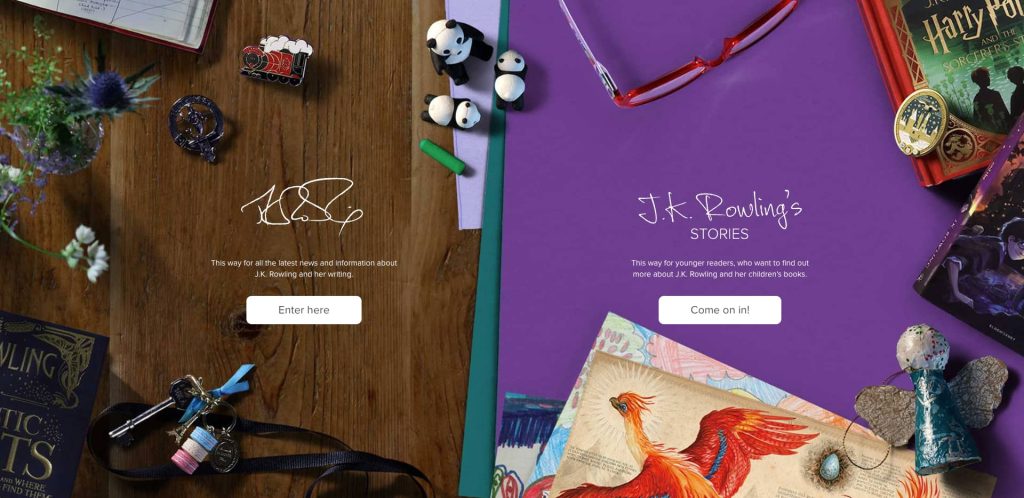
1. J.K. Rowling – Edinburgh, Scotland
Key Takeaways:
- Simple, elegant design focused on the author’s personal and professional brand.
- Dedicated sections for book releases, news, and upcoming events.
- User-friendly navigation with clear CTAs to purchase books and connect with readers.
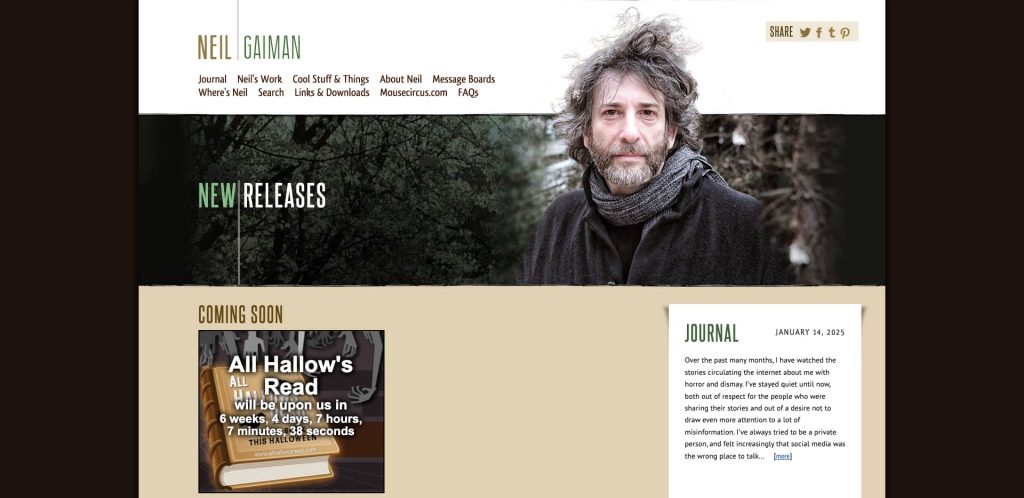
2. Neil Gaiman – Minneapolis, MN
Key Takeaways:
- Clean, minimalistic design that focuses on the content and author’s works.
- Integrated blog for regular updates, engaging readers with personal insights.
- Social media integration to keep readers connected with the author’s journey.
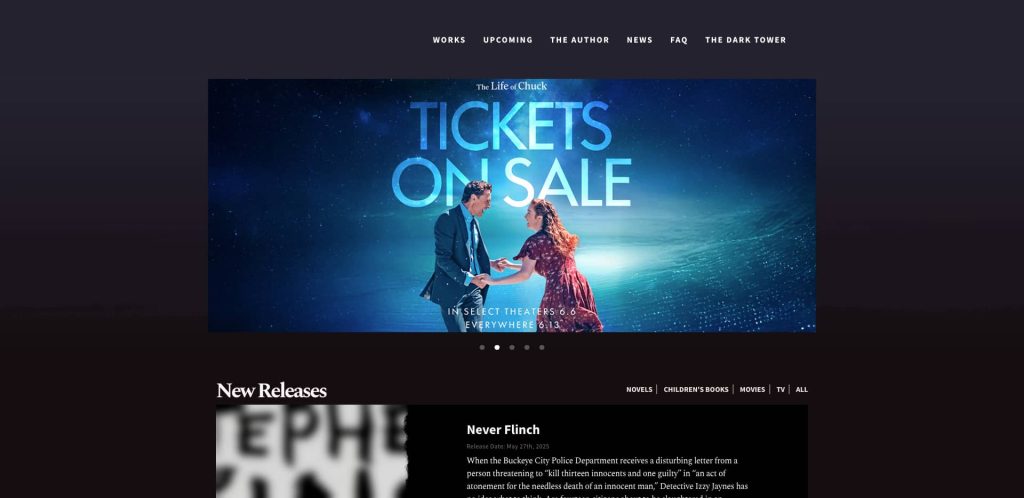
3. Stephen King – Bangor, ME
Key Takeaways:
- Bold, immersive design that fits the suspenseful and horror genre.
- Easy access to book pages with detailed descriptions and purchase options.
- Interactive elements like book trailers and press releases to engage fans.
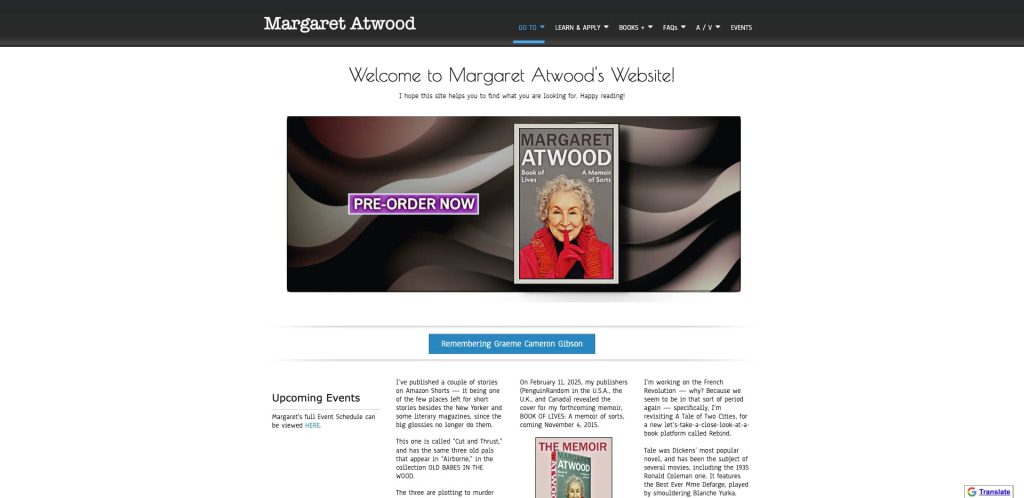
4. Margaret Atwood – Toronto, Canada
Key Takeaways:
- Elegant, sophisticated design that highlights the author’s literary works.
- Integration of media mentions, interviews, and news articles to engage readers.
- Simple, easy-to-navigate layout with a clear section for book sales.
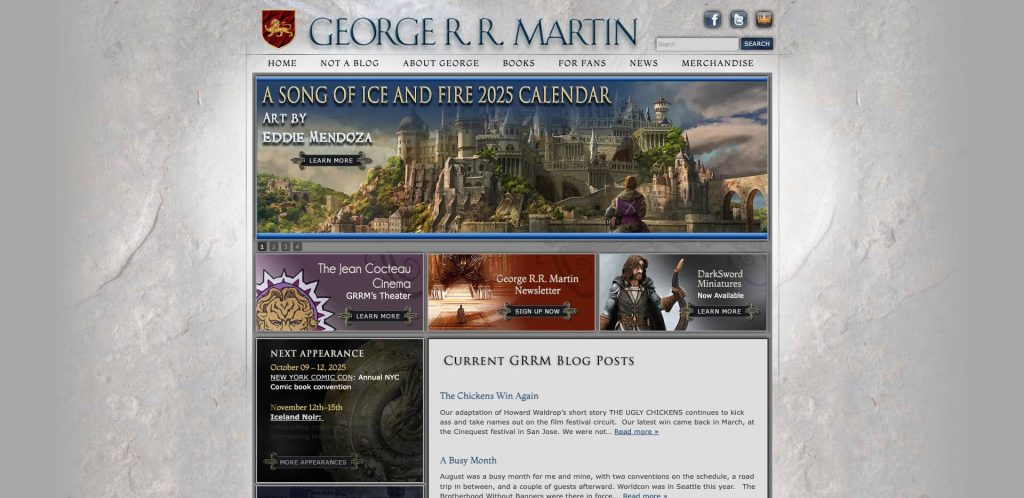
5. George R.R. Martin – Santa Fe, NM
Key Takeaways:
- Fantasy-inspired design with thematic elements that align with the author’s work.
- Dedicated book pages with detailed descriptions of each book in the “A Song of Ice and Fire” series.
- Clear sections for upcoming events, author news, and contact information.
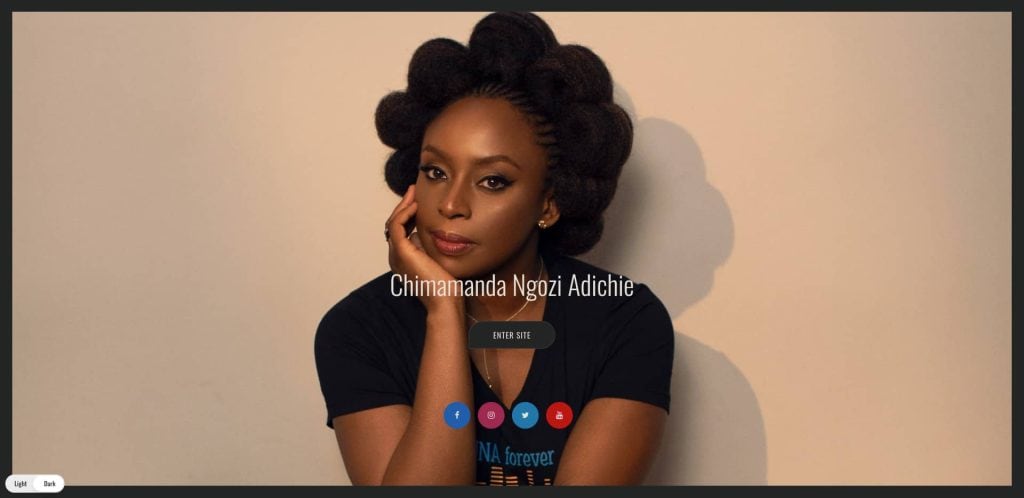
6. Chimamanda Ngozi Adichie – Lagos, Nigeria
Key Takeaways:
- Modern, visually appealing design that reflects the author’s progressive voice.
- Cleanly organized site with links to books, media appearances, and events.
- Direct calls to action for readers to purchase books and learn more about the author.
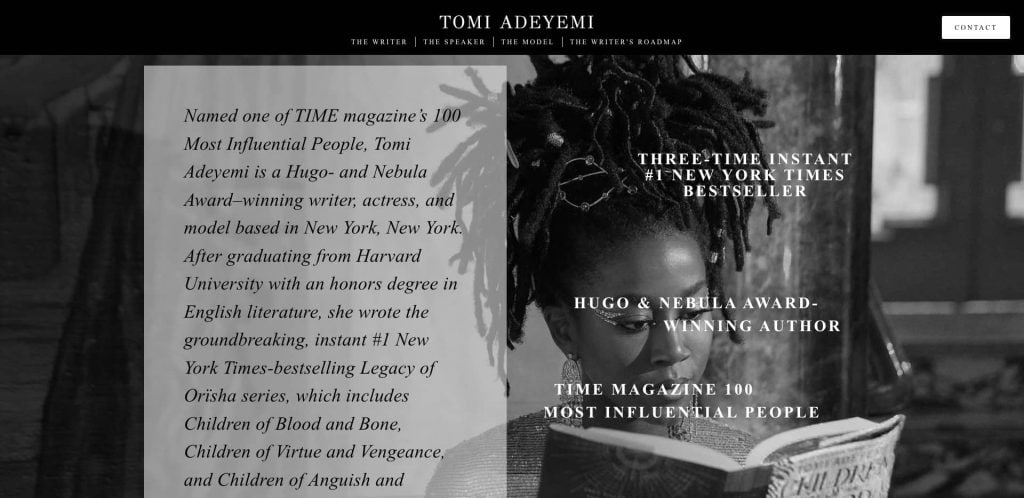
7. Tomi Adeyemi – Los Angeles, CA
Key Takeaways:
- Vibrant, bold design that reflects the fantasy genre of the author’s work.
- Interactive elements like book previews and author interviews engage readers.
- Easy-to-find links for purchasing books and joining the author’s newsletter.
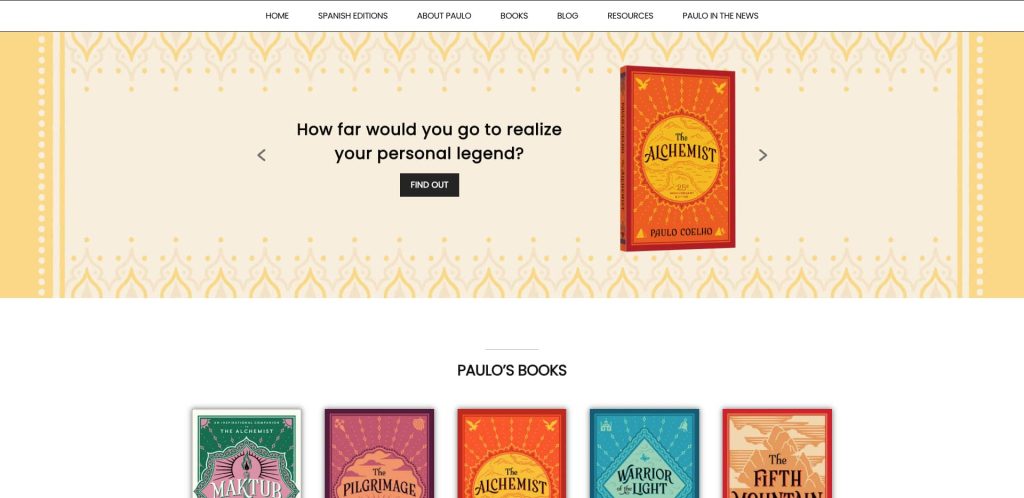
8. Paulo Coelho – Rio de Janeiro, Brazil
Key Takeaways:
- Minimalistic design that allows the author’s work and message to stand out.
- Sections for book sales, including international retailers, to cater to a global audience.
- Frequent updates on new books, events, and insights into the author’s work.

9. John Green – Indianapolis, IN
Key Takeaways:
- Playful, youthful design that resonates with the author’s young adult audience.
- Engaging content like blog posts, fan interactions, and book-related discussions.
- Direct, clear links for readers to purchase books and connect with the author.
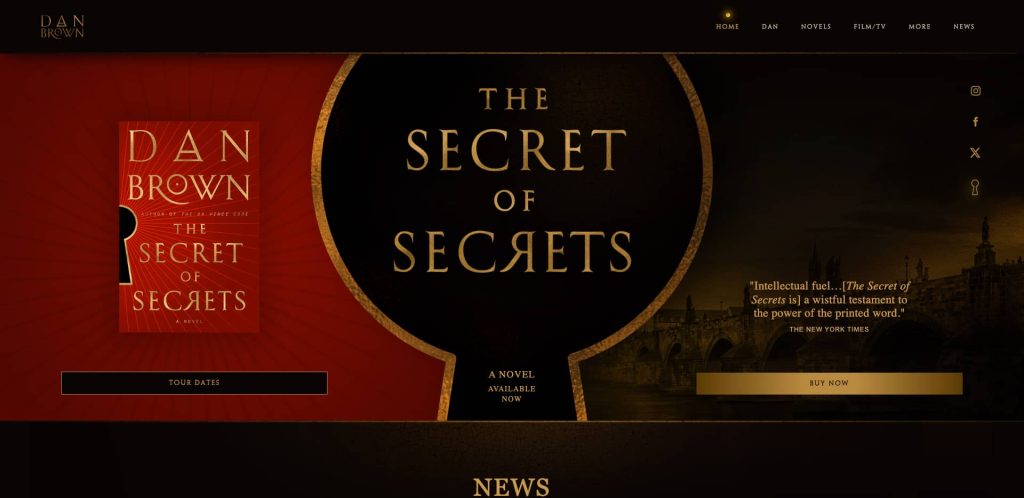
10. Dan Brown – Exeter, NH
Key Takeaways:
- Dark, sophisticated design that mirrors the themes of mystery and intrigue in the author’s books.
- Sections dedicated to each book, with detailed information and buying options.
- Easy navigation for fans to find events, media, and author news.
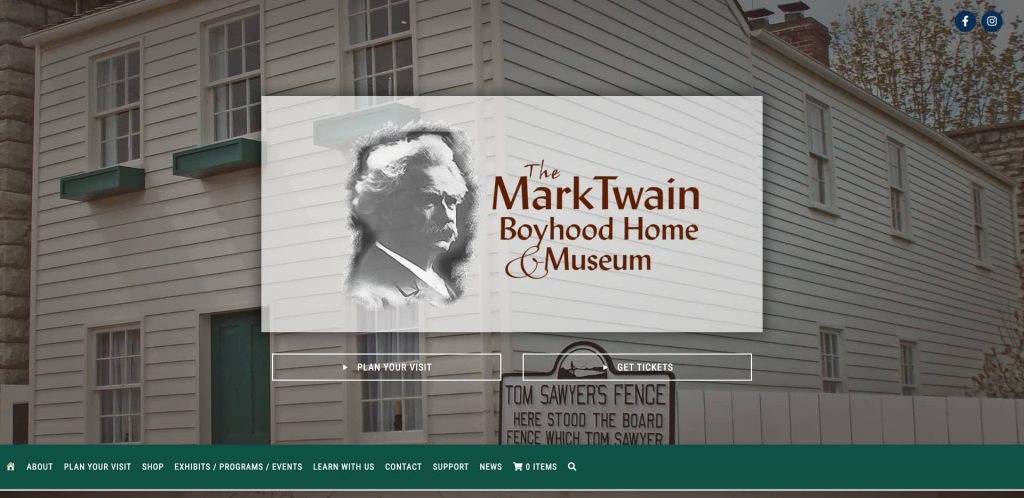
11. Mark Twain – Hannibal, MO
Key Takeaways:
- Historic, vintage design that aligns with the author’s legacy and works.
- Detailed sections for the author’s major works, along with multimedia content.
- Interactive timeline of Mark Twain’s life and career for educational engagement.
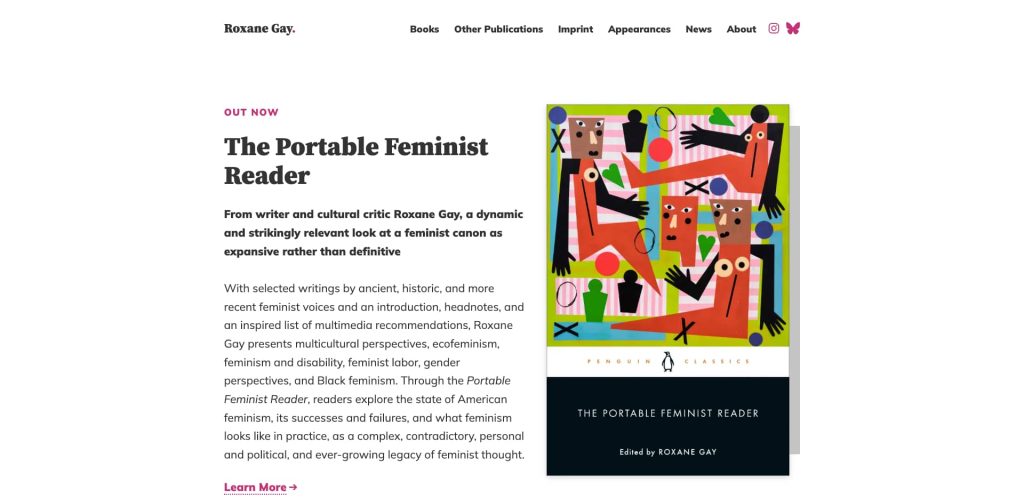
12. Roxane Gay – Lafayette, IN
Key Takeaways:
- Bold, contemporary design that reflects the author’s modern, thought-provoking work.
- Organized layout with quick access to books, events, and media.
- Integration of social media feeds and regular blog updates to engage readers.
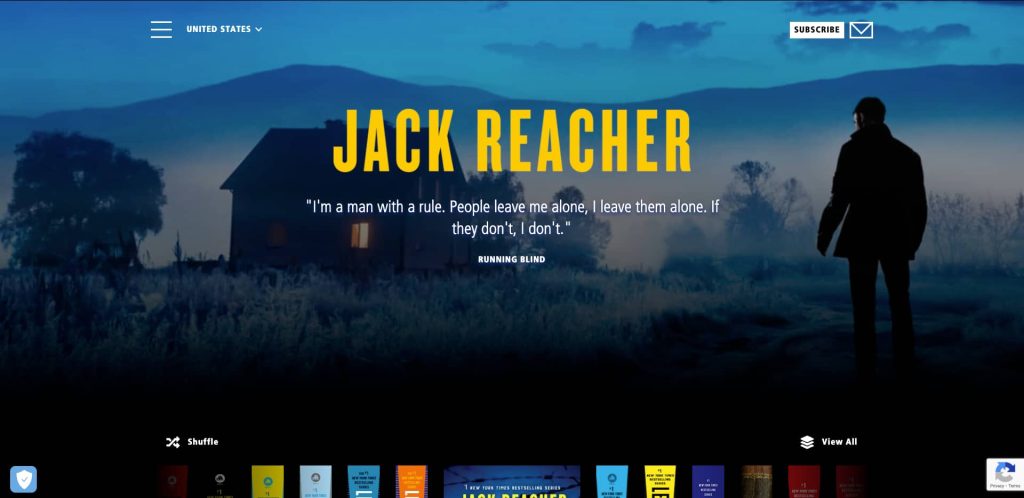
13. Lee Child – London, UK
Key Takeaways:
- Action-packed, visually compelling design that reflects the thriller genre.
- Clear layout with easy navigation to purchase books and learn about the author.
- Dynamic content like book trailers and news articles to keep fans informed.
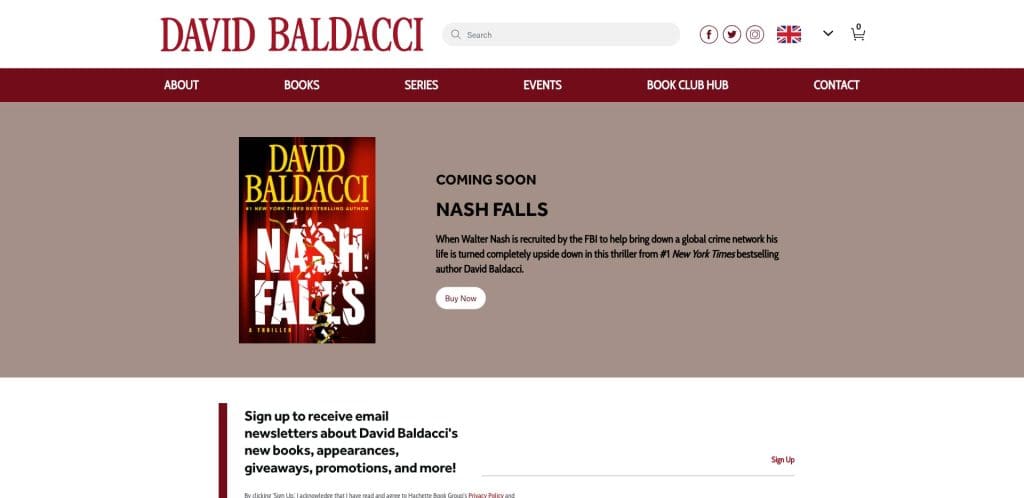
14. David Baldacci – Washington, D.C.
Key Takeaways:
- Clean, professional design with a focus on the author’s thrilling novels.
- Dedicated book pages with key details and purchase options for easy access.
- Regular updates on events, charity work, and media appearances.
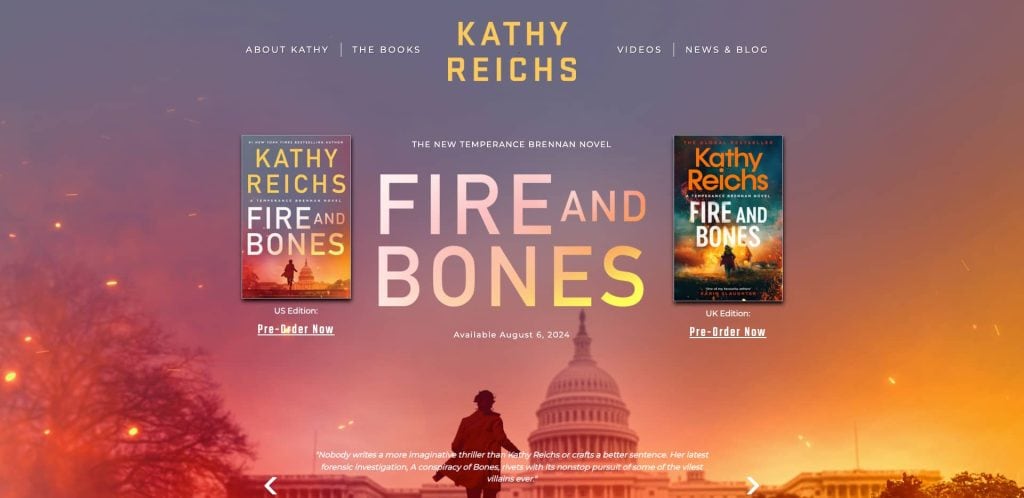
15. Kathy Reichs – Charlotte, NC
Key Takeaways:
- Sleek, modern design with imagery that reflects the forensic mystery genre.
- Sections for each of the author’s books and information about the TV series based on her work.
- Links to book retailers and clear CTAs for fans to buy books and engage.
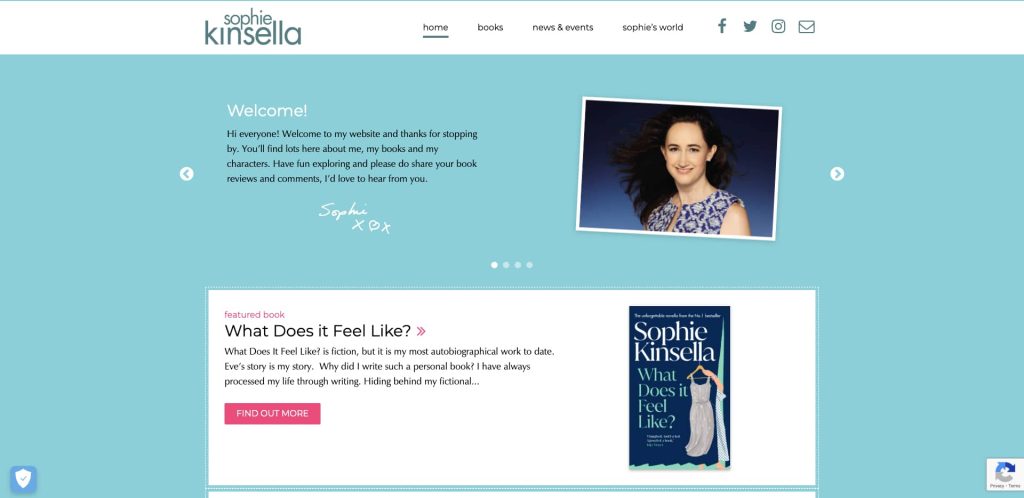
16. Sophie Kinsella – London, UK
Key Takeaways:
- Fun, whimsical design that reflects the author’s chic-lit style.
- Organized sections for book releases, media, and upcoming events.
- User-friendly navigation and a newsletter sign-up to keep readers engaged.
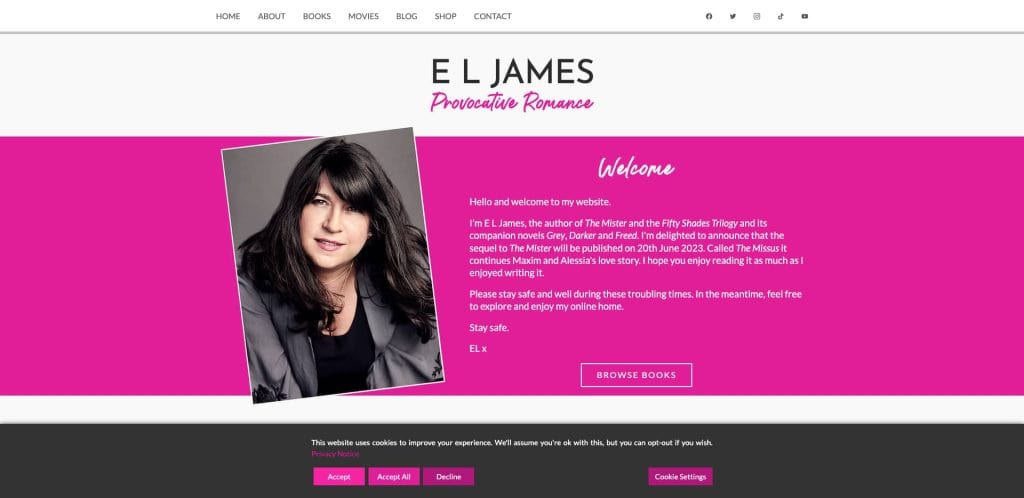
17. E.L. James – London, UK
Key Takeaways:
- Stylish design with a sleek, modern feel to match the author’s romance genre.
- Sections dedicated to each book, including multimedia content like interviews and video clips.
- Interactive features for fans to share their thoughts and connect with the author.
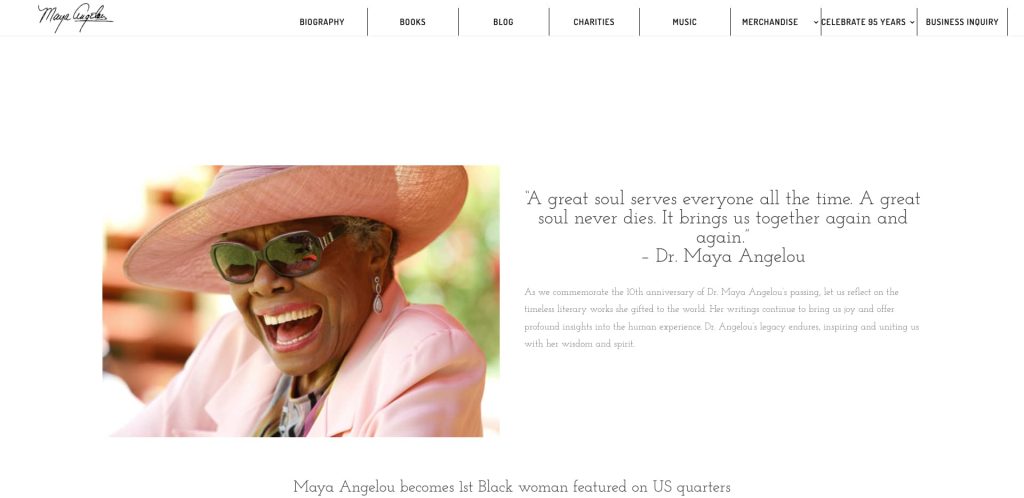
18. Maya Angelou – Winston-Salem, NC
Key Takeaways:
- Elegant, reflective design that aligns with the author’s powerful legacy.
- Sections that focus on the author’s poetry, books, and personal achievements.
- A tribute to the author’s influence, with multimedia content showcasing her life.
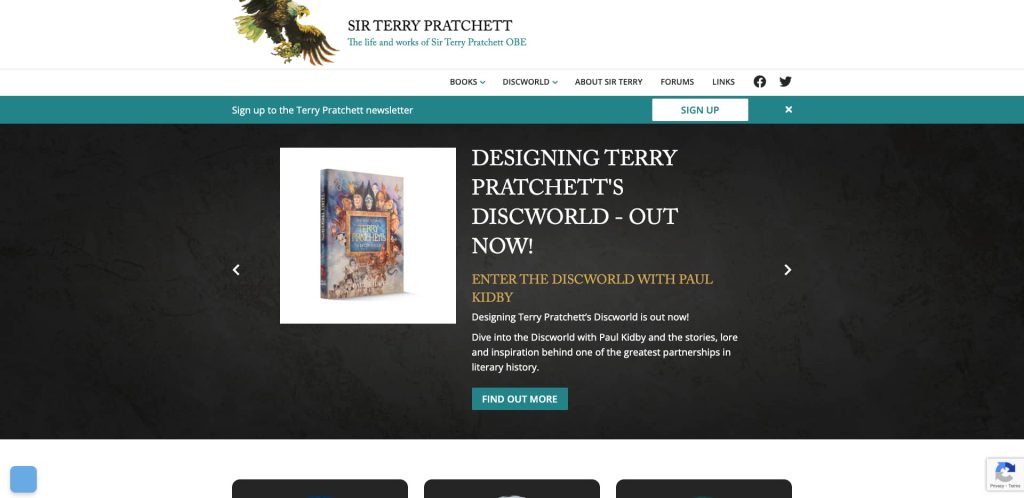
19. Terry Pratchett – Salisbury, UK
Key Takeaways:
- Fun, colorful design that aligns with the author’s comedic fantasy writing style.
- Well-organized book catalog with easy navigation to each of the Discworld books.
- Interactive elements like a forum and fan engagement opportunities.
Ready to Create Your Author Website?
Building a website that truly reflects your work as a published author is a critical step in growing your presence online and connecting with readers. Whether you’re just starting out or looking to update your current site, investing in a professional website designer or web developer can help you create a website that works. Don’t let the process overwhelm you. With the right website platform and tools, even authors who want a simple, easy-to-update site can build a website that serves as a powerful marketing tool for their career.
Many authors don’t realize that their website is often the first place readers go when they want to learn more about them and their books. By following the tips and best practices outlined in this guide, you’ll be well on your way to designing a good website that reflects your author voice and drives website traffic. From creating a page for each book to using design tools that fit your style, it’s easier than you think to make your website work for you.
If you’re ready to take the next step and create your author website, check out our agency’s full-service web design services today and start turning your author site into a resource that grows with your career.
Website Creation for Authors | FAQs
Why do I need an author website?
Authors need a website because it serves as the central hub for their digital presence. It’s where potential readers and industry professionals can learn about your work, purchase books, and connect with you directly. Even if you don’t have a large social media following, having a proper website gives you control over your online branding. With a good website, you can build your website to showcase your author name and books, increasing your traffic to your website traffic. A website can also serve as a place for fans to sign up for your mailing list or keep updated on your latest releases.
Can I create my website without a web designer?
Yes, you can absolutely build your website without hiring a web designer, especially with the popular website platforms available today. Platforms like WordPress, Squarespace, and Wix offer easy-to-update options and free websites or affordable templates. While web designers offer a more custom experience, many authors choose these platforms because they provide flexibility and can be set up quickly. Even if you don’t have experience, these tools are user-friendly and provide great examples to inspire your site design.
How can I ensure my website is effective?
To create a successful author web presence, focus on a clear layout, professional content, and user-friendly navigation. Your website should include an author page with a strong bio, showcase your books with dedicated pages for each one, and include easy-to-find contact information. Using examples of great websites as a guide can help you avoid common mistakes and build a website that reflects your personal brand and author wants. A site design that focuses on usability and aesthetics will make it easy for visitors to use your website and connect with you.
How often should I update my website?
It’s essential to regularly update your website to keep it fresh and engaging. You should update your website at least once a month to include new blog posts, book releases, or author news. Regular updates also help maintain your SEO ranking, keeping your website visible to search engines. If your website doesn’t reflect your current projects or goals, it may lose engagement. Even if you don’t have new releases, you can always update your website with relevant content like writing tips, upcoming events, or industry news.
What are the most important features of an author’s website?
The most important features of any website are a professional author page, a section for your books, and a way to engage with your readers. You should have a book author page that includes details about each book, a CTA to purchase, and a page for each book. Designing your site should also include features that encourage visitors to connect with your readers, such as a mailing list sign-up or an integrated blog. Additionally, adding examples of great websites in your field can inspire you to build a custom website that is both functional and visually appealing.
Should I use a free website platform?
Using a free website platform can be a good option if you’re on a budget, but it often comes with limitations, such as restricted design options or the inability to remove ads. However, platforms like WordPress or Wix allow you to create websites that look professional, even if you’re using a free option. Many authors don’t want to pay for website development services initially, but even if you don’t have the budget, these free options can still provide a solid digital presence. If you’re serious about your career as an author and need a custom design, investing in a professional designer can help elevate your site.
How do I drive traffic to my website?
Driving traffic to your website starts with creating content that resonates with your audience and improves your SEO. Regularly update your blog, engage on social media, and ensure your website is optimized for search engines. A website that works for your author web presence will bring more visitors. Including relevant keywords related to website development or book author topics will help your site rank higher in search results. Additionally, using tools like Google Analytics can help track your website’s performance, allowing you to refine your strategy over time.



